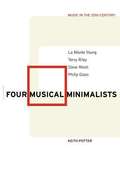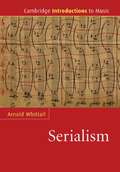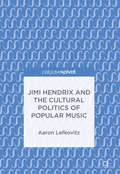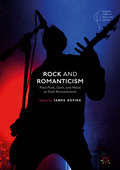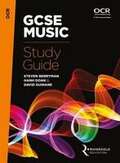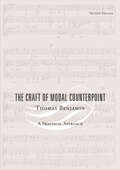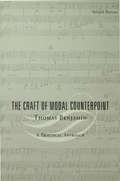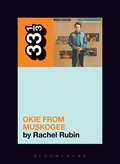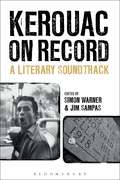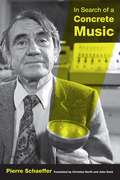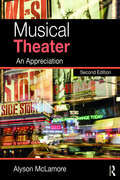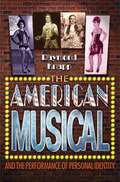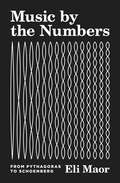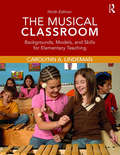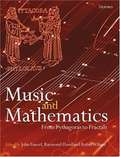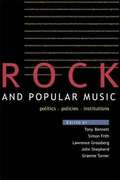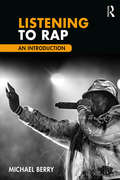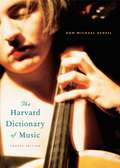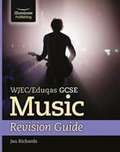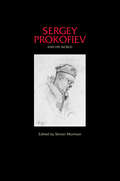- Table View
- List View
Four Musical Minimalists: La Monte Young, Terry Riley, Steve Reich, Philip Glass (PDF)
by Keith PotterThe American composers la Monte Young, Terry Riley, Steve Reich and Philip Glass are widely regarded as pioneers of the aesthetic and the techniques of minimalism in musical composition during the 1960s and early 1970s. This book offers the most detailed account so far of their early works, putting extensive discussion of the music into a biographical perspective. The true musical minimalism of these years is placed in the wider context of their music as a whole, and considered within the cultural conditions of the period which saw not only the rise of minimalism in the fine arts but also crucial changes in the theory and practice of musical composition in the Western cultivated tradition.
Serialism (PDF)
by Arnold WhittallFrom the earliest years of the 20th century composers sought ways in which to break from earlier musical traditions. Serialism is one of the most prominent innovations resulting from this. From Schoenberg to Stockhausen, Berg to Boulez, this introduction tells the story of how serialism emerged, and provides a basic outline of serial compositional techniques.
Jimi Hendrix and the Cultural Politics of Popular Music
by Aaron LefkovitzThis book, on Jimi Hendrix’s life, times, visual-cultural prominence, and popular music, with a particular emphasis on Hendrix’s relationships to the cultural politics of race, gender, sexuality, ethnicity, class, and nation. Hendrix, an itinerant “Gypsy” and “Voodoo child” whose racialized “freak” visual image continues to internationally circulate, exploited the exoticism of his race, gender, and sexuality and Gypsy and Voodoo transnational political cultures and religion. Aaron E. Lefkovitz argues that Hendrix can be located in a legacy of black-transnational popular musicians, from Chuck Berry to the hip hop duo Outkast, confirming while subverting established white supremacist and hetero-normative codes and conventions. Focusing on Hendrix’s transnational biography and centrality to US and international visual cultural and popular music histories, this book links Hendrix to traditions of blackface minstrelsy, international freak show spectacles, black popular music’s global circulation, and visual-cultural racial, gender, and sexual stereotypes, while noting Hendrix’s place in 1960s countercultural, US-exceptionalist, cultural Cold War, and rock histories.
Jimi Hendrix and the Cultural Politics of Popular Music
by Aaron LefkovitzThis book, on Jimi Hendrix’s life, times, visual-cultural prominence, and popular music, with a particular emphasis on Hendrix’s relationships to the cultural politics of race, gender, sexuality, ethnicity, class, and nation. Hendrix, an itinerant “Gypsy” and “Voodoo child” whose racialized “freak” visual image continues to internationally circulate, exploited the exoticism of his race, gender, and sexuality and Gypsy and Voodoo transnational political cultures and religion. Aaron E. Lefkovitz argues that Hendrix can be located in a legacy of black-transnational popular musicians, from Chuck Berry to the hip hop duo Outkast, confirming while subverting established white supremacist and hetero-normative codes and conventions. Focusing on Hendrix’s transnational biography and centrality to US and international visual cultural and popular music histories, this book links Hendrix to traditions of blackface minstrelsy, international freak show spectacles, black popular music’s global circulation, and visual-cultural racial, gender, and sexual stereotypes, while noting Hendrix’s place in 1960s countercultural, US-exceptionalist, cultural Cold War, and rock histories.
Rock and Romanticism: Post-Punk, Goth, and Metal as Dark Romanticisms (Palgrave Studies in Music and Literature)
by James RoviraRock and Romanticism: Post-Punk, Goth, and Metal as Dark Romanticisms explores the relationships among the musical genres of post-punk, goth, and metal and American and European Romanticisms traditionally understood. It argues that these contemporary forms of music are not only influenced by but are an expression of Romanticism continuous with their eighteenth- and nineteenth-century influences. Figures such as Blake, Wordsworth, Coleridge, Byron, Keats, Mary Shelley, Percy Shelley, Friedrich, Schlegel, and Hoffman are brought alongside the music and visual aesthetics of the Rolling Stones, the New Romantics, the Pretenders, Joy Division, Nick Cave, Tom Verlaine, emo, Eminem, My Dying Bride, and Norwegian black metal to explore the ways that Romanticism continues into the present in all of its varying forms and expressions.
Rock and Romanticism: Post-Punk, Goth, and Metal as Dark Romanticisms (Palgrave Studies in Music and Literature)
by James RoviraRock and Romanticism: Post-Punk, Goth, and Metal as Dark Romanticisms explores the relationships among the musical genres of post-punk, goth, and metal and American and European Romanticisms traditionally understood. It argues that these contemporary forms of music are not only influenced by but are an expression of Romanticism continuous with their eighteenth- and nineteenth-century influences. Figures such as Blake, Wordsworth, Coleridge, Byron, Keats, Mary Shelley, Percy Shelley, Friedrich, Schlegel, and Hoffman are brought alongside the music and visual aesthetics of the Rolling Stones, the New Romantics, the Pretenders, Joy Division, Nick Cave, Tom Verlaine, emo, Eminem, My Dying Bride, and Norwegian black metal to explore the ways that Romanticism continues into the present in all of its varying forms and expressions.
OCR GCSE Music Study Guide (PDF)
by Steven Berryman Hanh Doan David GuinaneThe OCR GCSE Music Study Guide is a definitive study guide for the 'reformed' GCSE (9-1) specification. Written by experts, this comprehensive guide: Covers all components of the GCSE: performing, composing and appraising. Gives support and practice in dealing with 'unfamiliar' repertoire. Offers comprehensive support for the composing briefs. Provides tests and activities to help monitor progress. Supplies practice questions and advice on essay writing. Introduces the terminology and techniques that the specification requires students to know.
OCR GCSE Music Study Guide
by Steven Berryman Hanh Doan David GuinaneA definitive study guide for the 'reformed' GCSE (9-1) specification. Written by experts, this comprehensive guide: • covers all components of the GCSE: Performing, Composing and Appraising • gives support and practice in dealing with ‘unfamiliar’ repertoire • offers comprehensive support for the composing briefs • provides tests and activities to help monitor progress • supplied practice questions and advice on essay writing • introduces the terminology and techniques that the specification requir...
The Craft of Modal Counterpoint: A Practical Approach
by Thomas Benjamin"The Craft of Modal Counterpoint" is the companion book to Benjamin's "The Craft of Tonal Counterpoint," recently republished in a second edition by Routledge. Modal counterpoint is the style of composition that was employed until the "tonal" revolution pioneered by Bach; it is the basis for most Early Music. Benjamin, a composer and pedagogue, offers a complete analysis of this important musical style. He begins by covering general aspects of the style, then covers in detail two, three, and four-part counterpoint. The Motet, an important form of vocal composition in this period, is studied separately. The book concludes with a brief anthology of key scores, 15 in all, for the student to study further. Also includes 132 musical examples.
The Craft of Modal Counterpoint
by Thomas Benjamin"The Craft of Modal Counterpoint" is the companion book to Benjamin's "The Craft of Tonal Counterpoint," recently republished in a second edition by Routledge. Modal counterpoint is the style of composition that was employed until the "tonal" revolution pioneered by Bach; it is the basis for most Early Music. Benjamin, a composer and pedagogue, offers a complete analysis of this important musical style. He begins by covering general aspects of the style, then covers in detail two, three, and four-part counterpoint. The Motet, an important form of vocal composition in this period, is studied separately. The book concludes with a brief anthology of key scores, 15 in all, for the student to study further. Also includes 132 musical examples.
Merle Haggard's Okie from Muskogee (33 1/3)
by Rachel Lee RubinEvery now and then, a song inspires a cultural conversation that ends up looking like a brawl. Merle Haggard's Okie from Muskogee, released in 1969, is a prime example of that important role of popular music. Okie immediately helped to frame an ongoing discussion about region and class, pride and politics, culture and counterculture. But the conversation around the song, useful as it was, drowned out the song itself, not to mention the other songs on the live album-named for Okie and performed in Muskogee-that Haggard has carefully chosen to frame what has turned out to be his most famous song. What are the internal clues for gleaning the intended meaning of Okie? What is the pay-off of the anti-fandom that Okie sparked (and continues to spark) in some quarters? How has the song come to be a shorthand for expressing all manner of anti-working class attitudes? What was Haggard's artistic path to that stage in Oklahoma, and how did he come to shape the industry so profoundly at the moment when urban country singers were playing a major role on the American social and political landscape?
Kerouac on Record: A Literary Soundtrack (PDF)
by Professor Simon Warner Mr Jim SampasHe was the leading light of the Beat Generation writers and the most dynamic author of his time, but Jack Kerouac also had a lifelong passion for music, particularly the mid-century jazz of New York City, the development of which he witnessed first-hand during the 1940s with Charlie Parker, Dizzy Gillespie and Thelonious Monk to the fore. The novelist, most famous for his 1957 book On the Road, admired the sounds of bebop and attempted to bring something of their original energy to his own writing, a torrent of semi-autobiographical stories he published between 1950 and his early death in 1969. Yet he was also drawn to American popular music of all kinds – from the blues to Broadway ballads – and when he came to record albums under his own name, he married his unique spoken word style with some of the most talented musicians on the scene. Kerouac's musical legacy goes well beyond the studio recordings he made himself: his influence infused generations of music makers who followed in his work – from singer-songwriters to rock bands. Some of the greatest transatlantic names – Bob Dylan and the Grateful Dead, Van Morrison and David Bowie, Janis Joplin and Tom Waits, Sonic Youth and Death Cab for Cutie, and many more – credited Kerouac's impact on their output. In Kerouac on Record, we consider how the writer brought his passion for jazz to his prose and poetry, his own record releases, the ways his legacy has been sustained by numerous more recent talents, those rock tributes that have kept his memory alive and some of the scores that have featured in Hollywood adaptations of the adventures he brought to the printed page.
In Search of a Concrete Music (PDF)
by Pierre SchaefferPierre Schaeffer’s In Search of a Concrete Music (À la recherche d’une musique concrète) has long been considered a classic text in electroacoustic music and sound recording. Now Schaeffer’s pioneering work—at once a journal of his experiments in sound composition and a treatise on the raison d’être of “concrete music”—is available for the first time in English translation. Schaeffer’s theories have had a profound influence on composers working with technology. However, they extend beyond the confines of the studio and are applicable to many areas of contemporary musical thought, such as defining an ‘instrument’ and classifying sounds. Schaeffer has also become increasingly relevant to DJs and hip-hop producers as well as sound-based media artists.
Musical Theater: An Appreciation
by Alyson McLamoreMusical Theater: An Appreciation, Second Edition offers a history of musical theater from its operating origins to the Broadway shows of today, combined with an in-depth study of the musical styles that paralleled changes on stage. Alyson McLamore teaches readers how to listen to both the words and the music of the stage musical, enabling them to understand how all the components of a show interact to create a compelling experience for audiences. This second edition has been updated with new chapters covering recent developments in the twenty-first century, while insights from recent scholarship on musical theater have been incorporated throughout the text. The musical examples discussed in the text now include detailed listening guides, while a new companion website includes plot summaries and links to audio of the musical examples. From Don Giovanni to Hamilton, Musical Theater: An Appreciation both explores the history of musical theater and develops a deep appreciation of the musical elements at the heart of this unique art form.
The American Musical and the Performance of Personal Identity
by Raymond KnappThe American musical has long provided an important vehicle through which writers, performers, and audiences reimagine who they are and how they might best interact with the world around them. Musicals are especially good at this because they provide not only an opportunity for us to enact dramatic versions of alternative identities, but also the material for performing such alternatives in the real world, through songs and the characters and attitudes those songs project. This book addresses a variety of specific themes in musicals that serve this general function: fairy tale and fantasy, idealism and inspiration, gender and sexuality, and relationships, among others. It also considers three overlapping genres that are central, in quite different ways, to the projection of personal identity: operetta, movie musicals, and operatic musicals. Among the musicals discussed are Camelot, Candide; Chicago; Company; Evita; Gypsy; Into the Woods; Kiss Me, Kate; A Little Night Music; Man of La Mancha; Meet Me in St. Louis; The Merry Widow; Moulin Rouge; My Fair Lady; Passion; The Rocky Horror Picture Show; Singin' in the Rain; Stormy Weather; Sweeney Todd; and The Wizard of Oz. Complementing the author's earlier work, The American Musical and the Formation of National Identity, this book completes a two-volume thematic history of the genre, designed for general audiences and specialists alike.
The American Musical and the Performance of Personal Identity
by Raymond KnappThe American musical has long provided an important vehicle through which writers, performers, and audiences reimagine who they are and how they might best interact with the world around them. Musicals are especially good at this because they provide not only an opportunity for us to enact dramatic versions of alternative identities, but also the material for performing such alternatives in the real world, through songs and the characters and attitudes those songs project. This book addresses a variety of specific themes in musicals that serve this general function: fairy tale and fantasy, idealism and inspiration, gender and sexuality, and relationships, among others. It also considers three overlapping genres that are central, in quite different ways, to the projection of personal identity: operetta, movie musicals, and operatic musicals. Among the musicals discussed are Camelot, Candide; Chicago; Company; Evita; Gypsy; Into the Woods; Kiss Me, Kate; A Little Night Music; Man of La Mancha; Meet Me in St. Louis; The Merry Widow; Moulin Rouge; My Fair Lady; Passion; The Rocky Horror Picture Show; Singin' in the Rain; Stormy Weather; Sweeney Todd; and The Wizard of Oz. Complementing the author's earlier work, The American Musical and the Formation of National Identity, this book completes a two-volume thematic history of the genre, designed for general audiences and specialists alike.
Music by the Numbers: From Pythagoras to Schoenberg
by Eli MaorHow music has influenced mathematics, physics, and astronomy from ancient Greece to the twentieth centuryMusic is filled with mathematical elements, the works of Bach are often said to possess a math-like logic, and Igor Stravinsky said "musical form is close to mathematics," while Arnold Schoenberg, Iannis Xenakis, and Karlheinz Stockhausen went further, writing music explicitly based on mathematical principles. Yet Eli Maor argues that music has influenced math at least as much as math has influenced music. Starting with Pythagoras, proceeding through the work of Schoenberg, and ending with contemporary string theory, Music by the Numbers tells a fascinating story of composers, scientists, inventors, and eccentrics who played a role in the age-old relationship between music, mathematics, and the sciences, especially physics and astronomy. Music by the Numbers explores key moments in this history, particularly how problems originating in music have inspired mathematicians for centuries. Perhaps the most famous of these problems is the vibrating string, which pitted some of the greatest mathematicians of the eighteenth century against each other in a debate that lasted more than fifty years and that eventually led to the development of post-calculus mathematics. Other highlights in the book include a comparison between meter in music and metric in geometry, complete with examples of rhythmic patterns from Bach to Stravinsky, and an exploration of a suggestive twentieth-century development: the nearly simultaneous emergence of Einstein's theory of relativity and Schoenberg's twelve-tone system.Weaving these compelling historical episodes with Maor's personal reflections as a mathematician and lover of classical music, Music by the Numbers will delight anyone who loves mathematics and music.
The Musical Classroom: Backgrounds, Models, and Skills for Elementary Teaching
by Carolynn A. LindemanThe Musical Classroom: Backgrounds, Models, and Skills for Elementary Teaching, Ninth Edition, is designed for students majoring in elementary or music education. Through eight editions, this book has been a market leader in its field. Its goal has been to help teachers—some who may only have a limited background in music—prepare to make music a part of the daily lives of their students. The model lessons remain the centerpiece of the book's long-lasting success. Supported by a collection of children's songs from around the world, instructional information for learning to play basic instruments, and the theoretical, pedagogical, and practical backgrounds needed for reaching all learners, pre-service and in-service teachers can make their classrooms musical classrooms. NEW to the ninth edition: The 2014 National Core Music Standards Multiple curricular connections to other subjects Expanded soprano recorder instruction unit Addition of the QChord® with Autoharp®/Chromaharp® instruction unit Updated and expanded prekindergarten section A significant infusion of technology throughout the text Mallet-instrument ensemble accompaniments A companion website linking to music sources with numerous resources for both students and instructors
Music And Mathematics: From Pythagoras To Fractals (PDF)
by John Fauvel Raymond Flood Robin WilsonFrom Ancient Greek times, music has been seen as a mathematical art, and the relationship between mathematics and music has fascinated generations. This collection of wide ranging, comprehensive and fully-illustrated papers, authorized by leading scholars, presents the link between these two subjects in a lucid manner that is suitable for students of both subjects, as well as the general reader with an interest in music. Physical, theoretical, physiological, acoustic, compositional and analytical relationships between mathematics and music are unfolded and explored with focus on tuning and temperament, the mathematics of sound, bell-ringing and modern compositional techniques.
Rock and Popular Music: Politics, Policies, Institutions (Culture: Policy and Politics Ser. #(PDF))
by Tony Bennett Lawrence Grossberg Shepherd Frith Simon Larry Grossberg Simon Frith John Shepherd Graeme TurnerRock and Popular Music examines the relations between the policies and institutions which regulate contemporary popular music and the political debates, contradictions and struggles in which those musics are involved. International in its scope and conception, this innovative collection explores the reasons for and ways in which governments have sought either to support or prohibit popular music in Canada, Australia and Europe as well as the impact of broadcasting policies in forming and shaping different musical communities. Rock and Popular Music is a unique collection suggesting significant new directions for the study of contemporary popular musics.
Rock And Popular Music: Politics, Policies, Institutions (Culture: Policy and Politics Ser.)
by Tony Bennett Lawrence Grossberg Shepherd Frith Simon Larry Grossberg Simon Frith John Shepherd Graeme TurnerRock and Popular Music examines the relations between the policies and institutions which regulate contemporary popular music and the political debates, contradictions and struggles in which those musics are involved. International in its scope and conception, this innovative collection explores the reasons for and ways in which governments have sought either to support or prohibit popular music in Canada, Australia and Europe as well as the impact of broadcasting policies in forming and shaping different musical communities. Rock and Popular Music is a unique collection suggesting significant new directions for the study of contemporary popular musics.
Listening to Rap: An Introduction
by Michael BerryOver the past four decades, rap and hip hop culture have taken a central place in popular music both in the United States and around the world. Listening to Rap: An Introduction enables students to understand the historical context, cultural impact, and unique musical characteristics of this essential genre. Each chapter explores a key topic in the study of rap music from the 1970s to today, covering themes such as race, gender, commercialization, politics, and authenticity. Synthesizing the approaches of scholars from a variety of disciplines—including music, cultural studies, African-American studies, gender studies, literary criticism, and philosophy—Listening to Rap tracks the evolution of rap and hip hop while illustrating its vast cultural significance. The text features more than 60 detailed listening guides that analyze the musical elements of songs by a wide array of artists, from Afrika Bambaataa and Grandmaster Flash to Nicki Minaj, Jay-Z, Kanye West, and more. A companion website showcases playlists of the music discussed in each chapter. Rooted in the understanding that cultural context, music, and lyrics combine to shape rap’s meaning, the text assumes no prior knowledge. For students of all backgrounds, Listening to Rap offers a clear and accessible introduction to this vital and influential music.
The Harvard Dictionary of Music: Fourth Edition (Harvard University Press Reference Library #10)
by Don Michael RandelThis classic reference work, the best one-volume music dictionary available, has been brought completely up to date in this new edition. Combining authoritative scholarship and lucid, lively prose, the Fourth Edition of The Harvard Dictionary of Music is the essential guide for musicians, students, and everyone who appreciates music.
WJEC/Eduqas GCSE Music Revision Guide (PDF)
by Jan RichardsThis GCSE Music revision guide is intended to complement the GCSE Music textbook, and is to be used alongside the information and support given by your teacher. It contains the necessary information that you need to know and learn when studying the GCSE course in Music. It is not a teaching guide, but it is a useful support for you to refer to and use, outlining essential information and musical knowledge, with guidance on how to answer certain types of question in the Appraising examination.
Sergey Prokofiev and His World (The\bard Music Festival Ser.)
by Simon MorrisonSergey Prokofiev (1891-1953), arguably the most popular composer of the twentieth century, led a life of triumph and tragedy. The story of his prodigious childhood in tsarist Russia, maturation in the West, and rise and fall as a Stalinist-era composer is filled with unresolved questions. Sergey Prokofiev and His World probes beneath the surface of his career and contextualizes his contributions to music on both sides of the nascent Cold War divide. The book contains previously unknown documents from the Russian State Archive of Literature and Art in Moscow and the Prokofiev Estate in Paris. The literary notebook of the composer's mother, Mariya Grigoryevna, illuminates her involvement in his education and is translated in full, as are ninety-eight letters between the composer and his business partner, Levon Atovmyan. The collection also includes a translation of Sigizmund Krzhizhanovsky's unperformed stage adaptation of Eugene Onegin, for which Prokofiev composed incidental music in 1936. The essays in the book range in focus from musical sketches to Kremlin decrees. The contributors explore Prokofiev's time in America; evaluate his working methods in the mid-1930s; document the creation of his score for the film Lieutenant Kizhe; tackle how and why Prokofiev rewrote his 1930 Fourth Symphony in 1947; detail his immortalization by Soviet bureaucrats, composers, and scholars; and examine Prokofiev's interest in Christian Science and the paths it opened for his music. The contributors are Mark Aranovsky, Kevin Bartig, Elizabeth Bergman, Leon Botstein, Pamela Davidson, Caryl Emerson, Marina Frolova-Walker, Nelly Kravetz, Leonid Maximenkov, Stephen Press, and Peter Schmelz.
